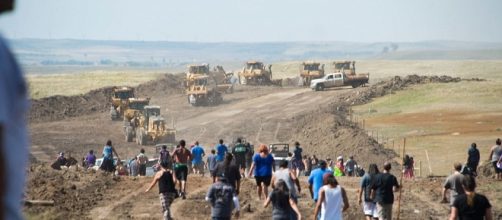Dakota Access pipeline workers bulldozed Native American cultural sitespossiblyto prevent their identification. Tim Mentz, owner of Makoce Wowapi, a Native American owned business that identifies cultural sites, identified 27 graves and 82 cultural sites on land owned by Dave Meyers on the Standing Rock Sioux reservation. The identification of cultural sites was crucial to halting the progress of the Dakota Access oil pipeline. The sites were destroyed the day after the Standing Rock Sioux Tribe filed an injunction in federal court. The water protectors of the Sacred Stone Camp tried to block the bulldozers.
Private security for DAPL used attack dogs and mace to drive them away. The protectors were too late, DAPL workers destroyed the cultural sites. The destruction is not surprising. The United States must erase evidence of indigenous history to justify internal colonization of indigenous peoples. The destruction has a long history.
History of the destruction of Native American culture
When Europeans arrived Native Americans were condemned as heathens needing conversion to Christianity; even by force. In Latin America, the American Southwest, Florida and California the Spanish used the converted Indians as slave labor for plantations at the Spanish missions. The missionaries eradicated indigenous culture and profited by using Indians as a free labor force.
When the Puritans arrived in Massachusetts their first action was to desecrate an Indian grave to rob it of food offerings. When the English colonies grew in power they subjugated the Indians under a moral code called the Blue Laws. If the Indians violated these laws by practicing their own spirituality, they were subject to imprisonment or death.
The racist and religiously bigoted ideology became a part of United States Indian law and policy.
History of the suppression of Native American spirituality
From 1870 to 1934 the government engaged in the suppression of Native American freedom of religion. Despite the high ideals of religious liberty embodied in the US constitution.
In 1883 the Secretary of the Interior said the heathen practices of Native Americans had to be eliminated. Congress formally outlawed the practice of traditional Native American religion. Any Native American caught practicing their culture was to be imprisoned for up to 30 days. In 1892 Congress strengthened the original restrictions saying that any Indian who advocated, practiced, or performed Native American ceremonies was to be imprisoned. Some of this blatant persecution ended with the enactment of the Indian Reorganization Act in 1934, but not all of it.
Native Americans had to fight for the right of religious liberty during the Red Power Era of the 1960s-1970s. In 1978 the American Indian Religious Freedom Act was enacted.
AIRFA proved a hollow victory. It has been significantly weakened by judicial interpretation. Native Americans lose rights to cultural sites because of the Eurocentric notion that a site is only a cultural site if ruins of a temple structure are shown. Native American religions often do not include the construction of permanent structures for religious worship. This is why the Standing Rock Sioux Tribe and Tim Mentz had to work so hard to identify the cultural sites. This is also why DAPL worked so hard to destroy them. The erasure of indigenous history is crucial to the perpetuation of United States internal colonization of indigenous peoples. The US must maintain the lie that, 'There was nothing here' before Europeans arrived.
Since the Indians did not utilize the land to its highest use, as John Locke said, Europeans had the right to take it from them. The United States and DAPL assert the highest use is an oil pipeline to acquire capital for powerful private interests. The Standing Rock Sioux know their history, and have lived in this land since before time. They will resist.

